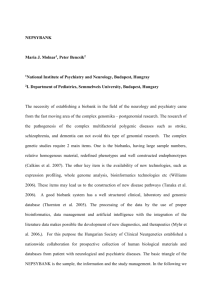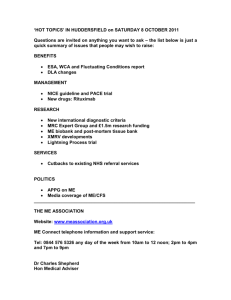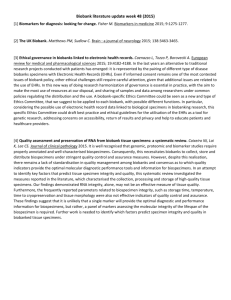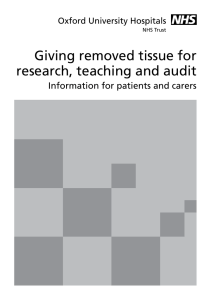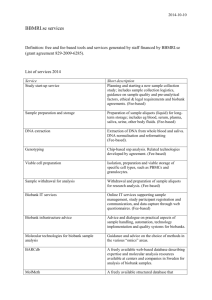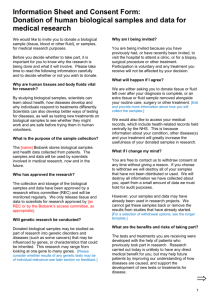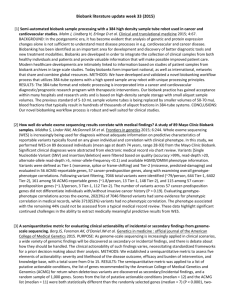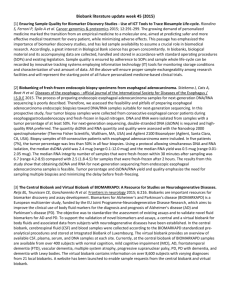Biobanking for research: a survey of patient population attitudes and understanding
advertisement
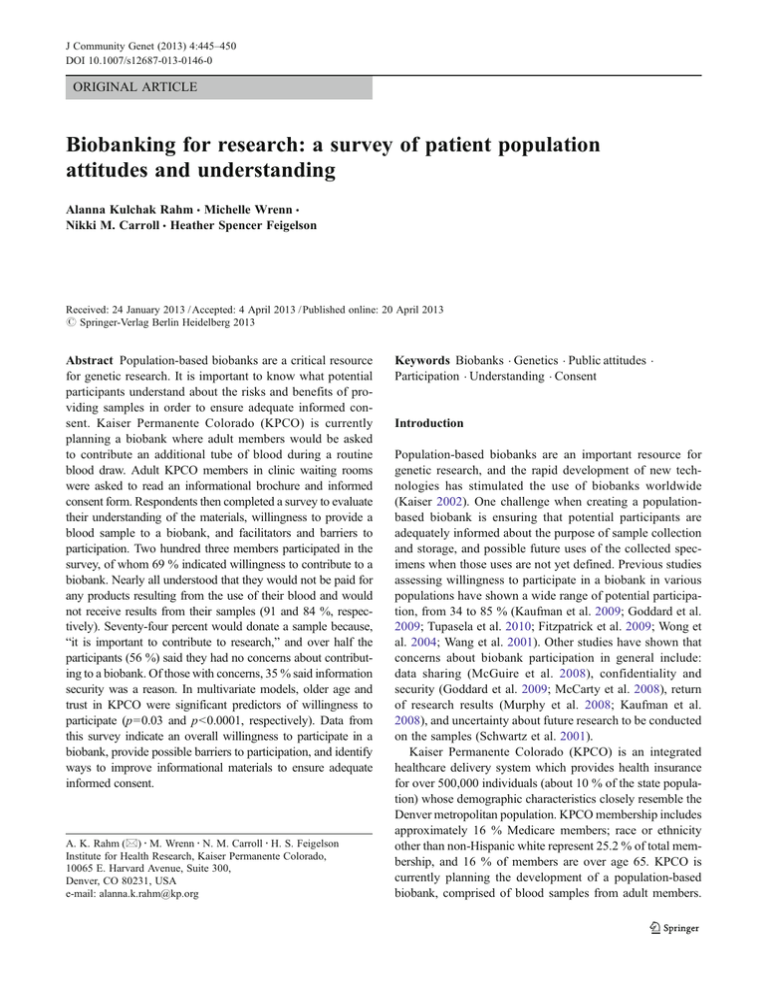
J Community Genet (2013) 4:445–450 DOI 10.1007/s12687-013-0146-0 ORIGINAL ARTICLE Biobanking for research: a survey of patient population attitudes and understanding Alanna Kulchak Rahm & Michelle Wrenn & Nikki M. Carroll & Heather Spencer Feigelson Received: 24 January 2013 / Accepted: 4 April 2013 / Published online: 20 April 2013 # Springer-Verlag Berlin Heidelberg 2013 Abstract Population-based biobanks are a critical resource for genetic research. It is important to know what potential participants understand about the risks and benefits of providing samples in order to ensure adequate informed consent. Kaiser Permanente Colorado (KPCO) is currently planning a biobank where adult members would be asked to contribute an additional tube of blood during a routine blood draw. Adult KPCO members in clinic waiting rooms were asked to read an informational brochure and informed consent form. Respondents then completed a survey to evaluate their understanding of the materials, willingness to provide a blood sample to a biobank, and facilitators and barriers to participation. Two hundred three members participated in the survey, of whom 69 % indicated willingness to contribute to a biobank. Nearly all understood that they would not be paid for any products resulting from the use of their blood and would not receive results from their samples (91 and 84 %, respectively). Seventy-four percent would donate a sample because, “it is important to contribute to research,” and over half the participants (56 %) said they had no concerns about contributing to a biobank. Of those with concerns, 35 % said information security was a reason. In multivariate models, older age and trust in KPCO were significant predictors of willingness to participate (p=0.03 and p<0.0001, respectively). Data from this survey indicate an overall willingness to participate in a biobank, provide possible barriers to participation, and identify ways to improve informational materials to ensure adequate informed consent. A. K. Rahm (*) : M. Wrenn : N. M. Carroll : H. S. Feigelson Institute for Health Research, Kaiser Permanente Colorado, 10065 E. Harvard Avenue, Suite 300, Denver, CO 80231, USA e-mail: alanna.k.rahm@kp.org Keywords Biobanks . Genetics . Public attitudes . Participation . Understanding . Consent Introduction Population-based biobanks are an important resource for genetic research, and the rapid development of new technologies has stimulated the use of biobanks worldwide (Kaiser 2002). One challenge when creating a populationbased biobank is ensuring that potential participants are adequately informed about the purpose of sample collection and storage, and possible future uses of the collected specimens when those uses are not yet defined. Previous studies assessing willingness to participate in a biobank in various populations have shown a wide range of potential participation, from 34 to 85 % (Kaufman et al. 2009; Goddard et al. 2009; Tupasela et al. 2010; Fitzpatrick et al. 2009; Wong et al. 2004; Wang et al. 2001). Other studies have shown that concerns about biobank participation in general include: data sharing (McGuire et al. 2008), confidentiality and security (Goddard et al. 2009; McCarty et al. 2008), return of research results (Murphy et al. 2008; Kaufman et al. 2008), and uncertainty about future research to be conducted on the samples (Schwartz et al. 2001). Kaiser Permanente Colorado (KPCO) is an integrated healthcare delivery system which provides health insurance for over 500,000 individuals (about 10 % of the state population) whose demographic characteristics closely resemble the Denver metropolitan population. KPCO membership includes approximately 16 % Medicare members; race or ethnicity other than non-Hispanic white represent 25.2 % of total membership, and 16 % of members are over age 65. KPCO is currently planning the development of a population-based biobank, comprised of blood samples from adult members. 446 Biobank participants will be consented through an opt-in process where they will be contacted specifically with information about the biobank and asked to contribute an additional tube of blood during a future routine blood draw. To evaluate understanding of our recruitment and consent materials, benefits and concerns about biobanks, and to determine willingness to contribute a blood sample to a biobank, we surveyed a sample of KPCO adult members. Methods Between October and November 2012, we approached adults in clinic waiting rooms and asked them to read an informational brochure and draft informed consent form, and then complete a short survey; we intended to survey at least 200 members. Clinic locations were chosen to maximize the potential for diversity in the study sample. Draft informational and consent materials were created based on similar materials from other successful biobanks across the country and tailored to our region, organization, and proposed consent processes. The informational brochure explained the purpose of the biobank and described how a KPCO member could participate. Specifically, that by consenting to contribute to the biobank, an extra tube of blood would be drawn during their next scheduled blood draw. The brochure specified that a special visit or blood draw was not required. The brochure also indicated that the blood would be stored indefinitely and used for unspecified genetic research in the future. The draft informed consent form used standard language and indicated that blood specimens would be stored for future genetic research. This draft consent form also stated that any future research would be reviewed and approved by the Institutional Review Board, that the sample could be linked to information in their medical record, and that they would not receive results or information about their sample except for cases where results provide information about a disease that is likely to cause early death if not treated. Possible risks of contributing to the biobank detailed in the draft consent form included risk of pain from the drawing of blood and risk of identification based on genetic information. Risk of insurance discrimination was also included, along with further details that in general, it is illegal for health insurance companies, group health plans, and employer groups to discriminate based on genetic information due to the Genetic Information Non-discrimination Act. The draft form also clarifies that this protection does not extend to discrimination by life insurance, disability insurance, or long-term-care insurance companies. Costs and payment information included in the draft consent stated that there is no cost to the patient or their insurance to provide a sample to the biobank and that they will not be paid for J Community Genet (2013) 4:445–450 participating, nor will they share in any profits should the research lead to any commercial products. We developed a 20-question survey to assess member understanding of biobanks, recruitment materials, and the informed consent, and willingness to contribute a sample to the biobank. The survey also included an item on trust in KPCO and concerns and benefits of biobank participation. Knowledge and understanding of the recruitment and consent materials were checked using multiple true/false questions regarding information in the draft materials. Trust in KPCO as a healthcare provider was measured with a five-point scale, ranging from “Do not trust KPCO as your health care provider” to “Trust KPCO completely as your healthcare provider.” Reasons for contributing or not to a biobank were determined using a multiple-answer list of common reasons gathered from the literature, with a write-in category for “other” responses. Survey results were calculated using percentages. The association between patient characteristics and willingness to contribute a sample to the biobank was evaluated using logistic regression adjusting for age, gender, race, education, and trust of provider. Odds ratios (OR) and 95 % confidence intervals (CI) were generated to measure the strength of the association for each factor. Using methods described by Allison (1999), we tested interaction effects between age and education, gender and education, and trust and education. Customary residual and effect statistics were examined to assess model fit and evaluate for outliers. All statistical analyses were performed using SAS 9.2 (SAS Institute Inc., Cary, NC). Results In total, 265 KPCO members were approached, and 203 agreed to review the draft biobank materials and complete the survey (77 % response rate). Survey respondents were similar to overall adult KPCO membership; 39 % were age 61 or older, 65 % were female, 22 % were race other than non-Hispanic white, and 84 % had completed education beyond high school (Table 1). Mean age of respondents was 53.8 years (range, 19–90). Results from logistic regression found that older age (>60 years of age) and trust in KPCO were associated with willingness to participate in the biobank (adjusted OR, 2.73; 95 % CI, 1.10–6.76 for the older age group and adjusted OR, 3.39; 95 % CI, 2.04–5.64 for trust in KPCO). Race/ethnicity, gender, and education were not significant predictors of willingness to participate. When asked about familiarity with biobanks and willingness to contribute to one, over two thirds (67 %) of respondents had not previously heard of biobanks or biorepositories, yet most (69 %) said they would provide an additional tube of blood to be stored in the biobank for future research. Sixty-one percent would still provide a sample even if KPCO was required to submit the information from the samples to a government J Community Genet (2013) 4:445–450 Table 1 Characteristics of survey participants and predictors of willingness to provide a sample to the KPCO biobank 447 Participant characteristics p value Number of patients (%), N=203 Unadjusted odds ratio (95 % CI)a Adjusted odds ratio (95 % CI)b 51 (25) 72 (36) 80 (39) Ref 2.58 (1.21–5.52) 3.92 (1.76–8.73) Ref 2.03 (0.87–4.73) 2.73 (1.10–6.76) 0.10 0.03 71 (35) 132 (65) Ref 1.26 (0.67–2.37) Ref 1.47 (0.70–3.07) 0.31 159 (78) 44 (22) Ref 0.43 (0.21–0.86) Ref 0.46 (0.21–1.04) 0.06 43 (21) 57 (28) 70 (35) 33 (16) Ref 1.14 (0.48–2.70) 0.78 (0.35–1.75) 1.60 (0.53–4.82) 3.58 (2.18–5.88) Ref 1.38 (0.51–3.76) 1.12 (0.43–2.91) 1.10 (0.32–3.73) 3.39 (2.04–5.64) 0.53 0.81 0.88 <0.0001 Age a Logistic models based on sample size of 192. Four respondents were excluded who did not answer whether they would be willing to contribute a sample to the biobank, and seven respondents were excluded for not answering trust in provider question b Model adjusted for age at diagnosis, gender, race/ethnicity, education, and trust of provider ≤40 41–60 61+ Gender Male Female Race/ethnicity White Other Education More than college College graduate Some college High school or less Trust in KPCO (continuous) database. Only 13 % said they would not contribute to a biobank, 16 % were unsure, and four individuals (2 %) did not answer the question. This high willingness to participate is likely due, in part, to “trust” in KPCO as their healthcare provider. Ninety-four percent of respondents ranked trust in KPCO as their healthcare provider at 3 or higher on a scale from 1 to 5 (51 % ranked trust in KPCO at 5: “trust KPCO completely as your healthcare provider”). In order to determine reasons for participating or not in a biobank, respondents were asked to “mark all that apply” to a checklist of possible reasons (Table 2). Over half (56 %) of respondents stated they had no concerns about contributing a sample to a biobank. As shown in Table 2, top reasons overall for contributing a sample to the biobank included importance to contribute to future research (74 %) and helping KPCO conduct genetic research for disease prevention and treatment (62 %). Nearly half of the respondents (47 %) saw potential benefit to themselves or family members as a reason to contribute to the biobank. The most common concern about participating in a biobank was fear about confidentiality and security (35 %). Among respondents willing to provide a sample to the biobank, reasons Table 2 Reasons for participating and not participating in a biobank Would give a sample, N=139 n (%) Reason to give samples to a biobank Important to contribute to future research I or my family member could benefit from this type of research Important to help KPCO in their efforts to further understanding of genetics and disease risk/survival/treatment I would not give a sample to the biobank Other Reasons for not contributing blood to a biobank Worried about the security and confidentiality Because results will not be shared with me Because I don’t know enough/might not approve of uses I do not have concerns about contributing blood sample Other a Would not give a sample, N=27 n (%) Unsure, N=33 Total, N=199a n (%) n (%) 118 (85) 76 (55) 100 (72) 8 (30) 4 (15) 7 (26) 22 (67) 13 (39) 17 (52) 148 (74) 93 (47) 124 (62) 2 (1) 2 (1) 15 (56) 1 (4) 4 (12) 2 (6) 21 (11) 5 (3) 27 (19) 3 (2) 4 (3) 105 (76) 4 (3) 18 (67) 8 (30) 13 (48) 3 (11) 1 (4) 24 (73) 9 (27) 10 (30) 3 (9) 0 (0) 69 (35) 20 (10) 27 (14) 111 (56) 5 (3) Four participants who did not answer whether they would contribute to a biobank were excluded from analysis 448 J Community Genet (2013) 4:445–450 were mostly to contribute to future research and to help KPCO further research efforts (85 and 72 %, respectively). Even respondents unsure about providing a sample felt that contributing to future research (67 %) and helping KPCO (52 %) were important benefits of a biobank. Respondents who were unsure or would not provide a sample were more concerned about security and confidentiality than those who would contribute a sample (73 and 67 % vs. 19 %). Of those unwilling or unsure about contributing a sample, additional concerns were higher regarding results not being shared (30 and 27 % vs. 2 % of those willing to participate) and because they may not approve of the future uses of their sample (48 and 30 % vs. 3 % of those willing to participate) Overall, 85 % of respondents correctly answered ≥6 of 9 questions about the information in the sample recruitment and consent documents, although 35 respondents did not answer at least one question. Most respondents understood they were consenting only to have a sample stored in a biobank and that additional review was required for any researcher to test their sample (79 %), that they would not receive results from biobank research (84 %), that they would not be paid for any products created from their sample (91 %), and that results from research would not be entered into their medical record (82 %) (Table 3). A majority of respondents understood that a separate blood draw was not required to submit a sample to the biobank (68 %) and that they could withdraw consent and their sample at any time (69 %). However, we found that many participants (60 %) answered incorrectly that their medical record information could be linked to their stored sample while another 8 % did not answer the question, leaving only 32 % of respondents who answered correctly. Interestingly, both respondents who were willing to contribute to a biobank and respondents who were unsure about contributing correctly answered ≥6 of 9 knowledge questions correctly more often (87 and 92 %, respectively) compared with respondents who would not contribute a sample (67 % answered at least six questions correctly). Discussion Most (69 %) adult members who agreed to participate in our survey indicated they would be willing to donate a blood sample for research, even though most of them had not previously heard of a biobank (67 %). Both age and trust in their medical care provider were significant predictors of willingness to provide a sample. The KPCO member potential participation rate of 69 % falls within the 34 to 85 % range of similar studies reporting respondents likely to submit a sample from previous literature (Kaufman et al. 2009; Goddard et al. 2009; Tupasela et al. 2010; Fitzpatrick et al. 2009; Wong et al. 2004; Wang et al. 2001). Our results are consistent with a survey of 500 members in another Kaiser Permanente region, where 69 % of respondents also stated they would participate in a biobank (Goddard et al. 2009). Similar predictions of participation have also been made when most respondents were unfamiliar with biobanks (Tupasela et al. 2010; Simon et al. 2011). Contributing to future research and helping KPCO were listed as important reasons for contributing to a biobank, even among those unsure about providing a sample. Benefit to future patients has been found as a primary reason for participating in biobanks in other surveys of potential participants (Simon et al. 2011; Kettis-Lindblad et al. 2006). Similar to other studies about barriers to participating in biobanks (Goddard et al. 2009), KPCO respondents who would not provide a sample or were unsure about participating in the biobank listed security and confidentiality as key concerns compared to those willing to provide a sample. Our survey asked KPCO members about attitudes towards participating in a biobank that does not yet exist. Actual biobank participation may vary from that determined on surveys such as this one (Johnsson et al. 2010); however, a recent review of hypothetical and actual participation in biobanks revealed that most biobanks had a participation rate higher than expected from survey data (Johnsson et al. 2010). Consistent with our finding that the majority of our Table 3 Knowledge and understanding of informational materials provided about biobank at KPCO Which statements do you think are true? Researchers must get approval before using my sample Will not receive personal results Will not have a separate blood draw specifically for the biobank An extra tube of blood will be drawn and stored in the biobank Only KPCO researchers can use the biobank I can remove my sample anytime I will be paid if my sample results in products to be sold My sample is linked to my medical record Results from biobank studies will not be in my medical record Correct n (%) Incorrect n (%) Missing n (%) 160 (79) 171 (84) 137 (68) 162 (80) 98 (48) 139 (69) 185 (91) 65 (32) 166 (82) 23 (11) 19 (9) 55 (27) 31 (15) 92 (45) 48 (24) 4 (2) 122 (60) 23 (11) 20 (10) 13 (6) 11 (5) 10 (5) 13 (6) 16 (8) 14 (7) 16 (8) 14 (7) J Community Genet (2013) 4:445–450 participants would provide a sample because it is important to contribute to research (74 %) and to help KPCO in its mission to improve health (62 %), and that trust in KPCO was a strong predictor of participation, Johnsson et al. (2010) also found that actual participants in biobanks were motivated by altruism, trust, and sense of duty. Others have also found that despite more discussion about barriers to biobank participation in general population focus groups with individuals not currently participating in biobanks, most respondents would still consider participating in genetic research, mainly for reasons pertaining to a desire “to help” and to contribute to “the greater good” (Lemke et al. 2010). Finally, survey respondents had a good understanding of the informational materials provided about the proposed biobank. Respondents who were unsure about contributing a sample and those who were willing to participate in the biobank answered knowledge questions correctly more often than those who would not participate in the biobank, indicating that the proposed informational materials provide adequate information for informed consent. Goddard and colleagues (2009) also found that respondents willing to contribute to a biobank were more likely to answer knowledge questions correctly (71 %) compared to those who would not provide a sample (51 %) and those who were unsure (56 %) (Goddard et al. 2009). Similarly, a study of actual biobank participants found that nature of the study, benefit to future patients, and voluntary nature of participation were the best understood domains of consent (Ormond et al. 2009). However, because only 32 % of respondents answered correctly that information from the medical record would be linked to their biobank sample, there is still room for clarification in the informational and consent materials. It is possible that respondents were unclear of the difference between results from biobank studies not being entered into their medical record (82 % of respondents answered correctly) and medical record information in general being connected to the stored sample for research purposes. An important limitation of our study is that this survey represents only a small percentage of the total KPCO member population. Further, we used a convenience sample of people in clinic waiting rooms. Although the demographics of our survey sample are similar to the entire KPCO adult member population, our results may not be representative of all KPCO members. Our high percentage of willingness to participate, in part, reflects only the initial willingness to read the materials and complete the survey; thus, it is possible actual biobank participation may be lower. However, other population-based biobanks have shown actual participation rates at least as high as or higher than predicted levels (Johnsson et al. 2010). Additionally, in 1999 and 2000, the NHANES population survey had 84 and 85 % participation rates for individuals providing a blood sample for storage in a repository for genetic research (McQuillan et al. 2003). 449 In conclusion, KPCO members in general are willing to provide an extra tube of blood for a population-based biobank that would store their samples for future, as yet undefined, research. Age and trust in KPCO as a healthcare provider were strong predictors of willingness, while altruistic motives of contributing to future research and helping KPCO were primary reasons listed for providing a sample to the biobank. Concerns about security and confidentiality remain primary barriers for those unwilling to provide a sample. Informational and consent documents appear to provide adequate information for informed consent; however there is room for improvement to help participants understand how information from their medical record will be linked to their sample in the biobank. Acknowledgments This project was funded by and conducted through the Center for Excellence in Cancer and Genomics in the Institute for Health Research, Kaiser Permanente Colorado. References Allison P (1999) Logistic regression using the SAS system, 1st edn. SAS Institute, Cary Fitzpatrick PE, McKenzie KD, Beasley A, Sheehan JD (2009) Patients attending tertiary referral urology clinics: willingness to participate in tissue banking. BJU Int 104:209–213 Goddard KA, Smith KS, Chen C, McMullen C, Johnson C (2009) Biobank recruitment: motivations for nonparticipation. Biopreserv Biobank 7:119–121 Johnsson L, Helgesson G, Rafnar T et al (2010) Hypothetical and factual willingness to participate in biobank research. Eur J Hum Genet 18:1261–1264 Kaiser J (2002) Biobanks. Population databases boom, from Iceland to the U.S. Science 298:1158–1161 Kaufman D, Murphy J, Scott J, Hudson K (2008) Subjects matter: a survey of public opinions about a large genetic cohort study. Genet Med 10:831–839 Kaufman DJ, Murphy-Bollinger J, Scott J, Hudson KL (2009) Public opinion about the importance of privacy in biobank research. Am J Hum Genet 85:643–654 Kettis-Lindblad A, Ring L, Viberth E, Hansson MG (2006) Genetic research and donation of tissue samples to biobanks. What do potential sample donors in the Swedish general public think? EurJ Publ Health 16:433–440 Lemke AA, Wolf WA, Hebert-Beirne J, Smith ME (2010) Public and biobank participant attitudes toward genetic research participation and data sharing. Publ Health Genomics 13:368–377 McCarty CA, Chapman-Stone D, Derfus T, Giampietro PF, Fost N (2008) Community consultation and communication for a population-based DNA biobank: the Marshfield clinic personalized medicine research project. A J Med Gen A 146A:3026–3033 McGuire AL, Hamilton JA, Lunstroth R, McCullough LB, Goldman A (2008) DNA data sharing: research participants’ perspectives. Genet Med 10:46–53 McQuillan GM, Porter KS, Agelli M, Kington R (2003) Consent for genetic research in a general population: the NHANES experience. Genet Med 5:35–42 Murphy J, Scott J, Kaufman D et al (2008) Public expectations for return of results from large-cohort genetic research. Am J Bioeth 8:36–43 450 Ormond KE, Cirino AL, Helenowski IB, Chisholm RL, Wolf WA (2009) Assessing the understanding of biobank participants. Am J Med Genet A 149A:188–198 Schwartz MD, Rothenberg K, Joseph L, Benkendorf J, Lerman C (2001) Consent to the use of stored DNA for genetics research: a survey of attitudes in the Jewish population. Am J Med Genet 98:336–342 Simon CM, L’heureux J, Murray JC et al (2011) Active choice but not too active: public perspectives on biobank consent models. Genet Med 13:821–831 J Community Genet (2013) 4:445–450 Tupasela A, Sihvo S, Snell K et al (2010) Attitudes towards biomedical use of tissue sample collections, consent, and biobanks among Finns. ScandJ Publ Health 38:46–52 Wang SS, Fridinger F, Sheedy KM, Khoury MJ (2001) Public attitudes regarding the donation and storage of blood specimens for genetic research. Community Genet 4:18–26 Wong ML, Chia KS, Yam WM, Teodoro GR, Lau KW (2004) Willingness to donate blood samples for genetic research: a survey from a community in Singapore. Clin Genet 65:45–51

